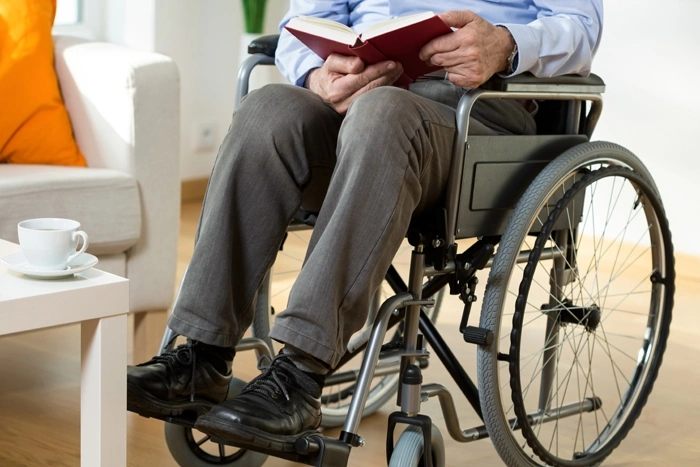Let me ask you a hypothetical question: Do you have a wheelchair accessible home?
If you took a tumble tomorrow and had to spend a few weeks or months in a wheelchair, would you be able to use your front door? Could you use the bathroom? Could you still make dinner? The answer for most of us is, probably not!
My point is this, accessibility is a perspective. It’s a learnt way of seeing and looking at things.
Most of us, only see through one set of lenses. It’s not a judgment. It’s just human nature.
Now let’s say, you are considering home care for your aging parent? Or a mobility-restricted friend or family member is coming to stay. Or, you yourself are aging, and your needs are changing. What immediate changes would you need to make – or could you make today, to start accomodating their needs?
The following list is a cheat sheet of quick adjustments. A few easy alterations that start to address the crucial issue of a wheelchair accessible home.
It’s not comprehensive, by any means, but if nothing else it should start a conversation, or provoke a new way of thinking.
Accessibility is important. It makes you, or your guest, feel at home, welcome, considered, comfortable. It facilitates independence, a sense of safety and is conducive to overall mental and physical health.
So, the next question is obviously, how and where do I start?
And how much exactly will it cost?
Well, the straight answer is, it’s up to you and your particular situation.
If you have the luxury of time and resources, you can work accessibility considerations into the design of your home, over time. If you do not have the luxury of time, the below six “quick fixes” are a place to start, the first steps towards making your home more welcoming for someone in a wheelchair.
Wheelchair Accessible Home Cheat Sheet: The Big 6
1. Doorknobs
It may sound obvious, but doorknobs can be a real problem. By default, doorknobs are made to be used from a standing position. So, sit down and test your doorknobs. Certain types of doorknobs are easier to use than others. The round handles are usually the most troublesome. Some will work from a seated position, some won’t. If you struggle, you know. You either need to lower the knobs, or install alternative lever-like handles that you can just pull down on, instead of having to turn.
2. Doorways
The average doorway is 36 inches. The average wheelchair is 21 – 30 inches. The standard width door frames are not always wide enough for wheelchairs to pass through. Most of us can’t afford to remodel our entire home, but we can fairly easily add a few inches to our doorways by removing doors and door frames. Changing the direction doors open, can also add a few cm’s to one side or the other.
3. Floors
On a sliding scale, tiles, wood, and laminate are best, the smoother the surface, the easier it is to maneuver around. Carpets are okay, but harder work – more resistant. Rugs are a no-no. So, the first thing you can do from a user-friendly, safety, maneuverability perspective, is remove all rugs. They are a potential hazard to wheelchair users and caregivers alike.
4. In the bathroom
The bathroom and kitchen are probably one of the two areas, that will require the most investment and adjustment, long term.
First prize, is a completely wheelchair accessible bathroom, that includes a completely flat roll-in shower.
For the interim, if your shower has a step, consider adding a threshold or making a small ramp to help make it easier to roll into.
Grab bars are an essential, easy-to-install addition that can be placed around the toilet and bath to help with transfers.
Other recommended additions include non-slip pads for the bottom of the tub or shower, shower benches, and bath seats or chairs.
View our full range of handy bathroom aids
5. In the kitchen
This may take a little maneuvering, but with a little thought, it’s usually quite doable. Take a seat, then critically review your current setup.
Is the kettle accessible? Is there room to move? Is the coffee accessible? The mugs, glasses and plates? Can you reach the microwave? How is the fridge packed? Are the frequently used items packed lower, or higher? The washing machine and dryer – are they front loading and placed so that the doors both open out and away, so you can actually switch laundry from one to the other when seated?
6. Your Entrance
Most homes are not designed with a wheelchair in mind, so it is highly likely you will need to build a wheelchair ramp to facilitate accessibility. When you do, there are a few considerations to bear in mind.
i) There are regulations regarding the degree of incline. ii) It will need to be wide enough to accommodate a chair, with a little extra room on each side.
iii) Handrails are recommended to prevent falls and provide extra support. iv) Add a non-slip surface, for added grip when the weather is wet.
And that’s it. Our cheat sheet of quick fixes, that will hopefully inspire a whole new way of thinking and encourage you to start addressing the crucial issue of accessibility in your home.

